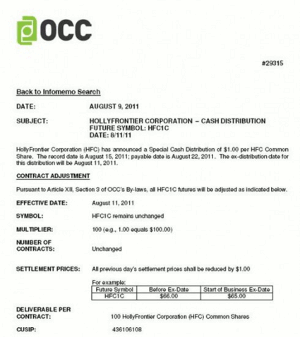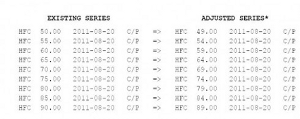As earnings season approaches, Alan Ellman of TheBlueCollarInvestor.com explains how strong earnings that sometimes result in special dividends can affect covered calls.
Every so often we will see a company declare a special dividend, which is separate from the typical recurring dividend cycle, if there is one. It is frequently a reflection of exceptionally strong earnings and/or a company with a large cash balance. It is a positive sign regarding the financial health of this corporation. Some of you may remember the $3 one-time cash dividend announced by Microsoft in 2004 to “relieve its balance sheet of a large cash balance”…such problems we should all have!
When a stock generates a special cash dividend, let’s say $1 per share, the price of the stock is then adjusted by decreasing by that amount. This adjustment will take place the day after the dividend is distributed. Now I can see the wheels turning in your heads…I’ll buy the stock on the record date and sell it before the price adjusts for this distribution…I’m going to make out like a bandit! Not so fast…don’t quit your day job. The earliest you can sell your stock and still be entitled to the special cash dividend is the date the stock begins trading on an “ex-distribution basis” or one day after the dividend date. Oh well.
Now let’s bring this information into our world of covered call writing. We sell call options, which implies that someone is buying them (we’re the “casino”…they’re the players). Let’s say we buy a stock for $69 and sell the $70 call. The holder of that call option bought the call with the strike $1 higher than the market value of the stock. If a $1 cash dividend is distributed prior to expiration causing the stock price to be adjusted down by $1, his position would be dramatically compromised. To make this situation fair and the option buyer “whole” the strike price is decreased by the dividend amount or $1 in this scenario. So a $70 call becomes a $69 call. All other factors being equal, the market value and strike drops an equal amount and so the strike is still $1 from the market value.
Where to Get Information on Special Cash Dividends
www.cboe.com
www.optionsclearing.com
Real-Life Example
On August 11, 2011, HollyFrontier (HFC) announced a special, one-time cash dividend of $1. Here is what that information looked like on the second site listed above:
HFC - special cash dividend
Here is a chart taken from the CBOE site reflecting the change in the strike prices:
HFC - Change in strike pricesHow to Calculate Our Covered-Call Returns
If we bought a stock for $69 and sold the $70 call for $3, our initial calculation would be:
ROO= $3/$69 = 4.3%
When we receive a cash dividend of $1, in essence our cost basis is reduced by $1 or $69 becomes $68:
ROO = $3/$68 = 4.4%
Our long stock position is decreased by $1 and that is why I don’t like to calculate the extra $1 as additional option premium. It would skew the results and not account for the reduced share value:
$4/$69 = 5.8%
These calculations are NOT for tax purposes. They are used to assess the best covered call decisions at that specific point in time.
Strike Prices if the Dividend Were Not an Even Number
The OCC Security Committee evaluates each situation on a case-by-case basis but generally speaking if a dividend if greater than 12 1/2 cents the strike price can be adjusted by the amount of the dividend. If HFC had declared a one-time cash dividend of $1.25, the $70 strike would become $68.75. As new series of options are published, the standard strike prices will return.
Special Dividends in the Form of Shares Instead of Cash
Once again contract adjustments are done on a case-by-case basis but generally speaking if a 5% stock dividend was declared on a $30 stock:
Share value is determined by the following equation: $30/1.05 = $28.57
The new strike price will be $28.57
Each contract will now deliver 105 shares instead of the original 100
Conclusion
Special cash dividends will frequently impact our strike prices due to the decrease in share value after the distribution. Because these are handled on a case-by-case basis, it is important to understand how your position has changed due to the unexpected cash or stock distribution. The websites I referenced above are great resources for locating this information as are specialists who work at your brokerage.
By Alan Ellman of TheBlueCollarInvestor.com












